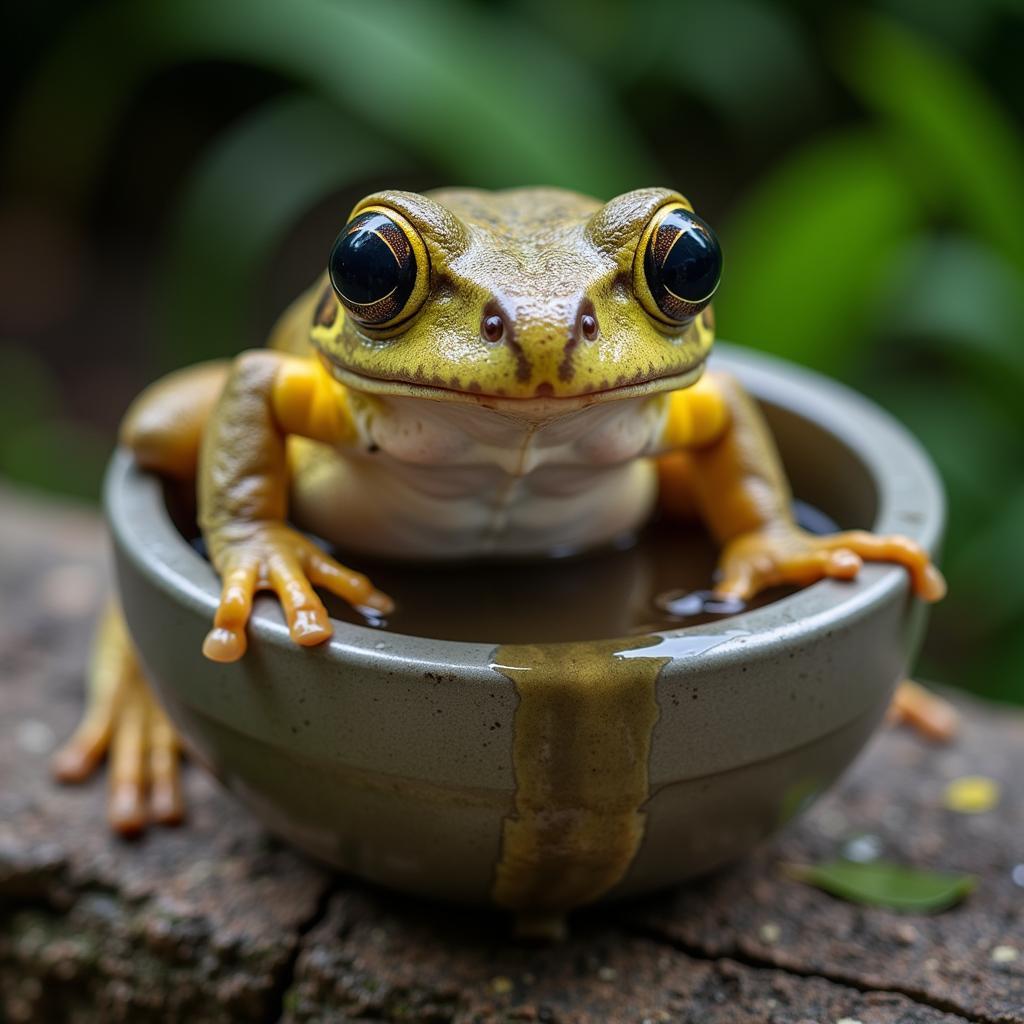Cuban tree frogs, with their voracious appetites and adaptable nature, have become a common sight in many areas outside their native Cuba. If you find yourself caring for one of these invasive amphibians, it’s essential to know the right Cuban Tree Frog Food to ensure their health and well-being. Providing a proper diet is crucial for these fascinating creatures, and this guide will delve into the specifics of what to feed your Cuban tree frog.
What Do Cuban Tree Frogs Eat?
In the wild, Cuban tree frogs are opportunistic feeders, meaning they’ll consume just about anything they can catch. Their diet primarily consists of insects, but they are also known to prey on smaller frogs, lizards, and even small mammals. This varied diet is key to their survival and explains their invasive success.
Insects: The Staple Diet
The bulk of a Cuban tree frog’s diet should consist of insects. Crickets are a readily available and nutritious option, offering a good balance of protein and other essential nutrients. Other suitable insects include mealworms, roaches, waxworms (as an occasional treat), and flies.
Variety is Key: Expanding the Menu
While crickets can form the foundation of your frog’s diet, offering variety is essential for optimal health. Different insects provide different nutrients, mimicking their natural diet in the wild. Consider adding other feeder insects like dubia roaches, which are higher in protein and calcium than crickets.
Supplementing for Success: Vitamins and Minerals
Just like any other pet, Cuban tree frogs need vitamins and minerals to thrive. Dusting their feeder insects with a calcium and vitamin D3 supplement is crucial, especially for younger frogs. This helps prevent metabolic bone disease, a common ailment in captive amphibians.
How Often Should You Feed a Cuban Tree Frog?
The frequency of feeding depends on the frog’s age and size. Young, growing frogs should be fed daily, while adults can be fed every two to three days. A good rule of thumb is to offer as much food as the frog will consume in a 15-minute period.
Avoiding Overfeeding: Signs to Watch For
Overfeeding can lead to obesity and other health issues. Watch for signs like excessive weight gain, lethargy, and regurgitation. If you notice any of these symptoms, reduce the feeding frequency and consult a veterinarian specializing in exotic animals.
Creating a Naturalistic Habitat: Encouraging Natural Feeding Behaviors
Cuban tree frogs are arboreal, meaning they spend most of their time in trees. Creating a naturalistic habitat with branches, foliage, and a shallow water dish will encourage natural behaviors, including foraging and hunting.
Providing Hiding Spots: Reducing Stress and Promoting Well-being
Including hiding spots in the enclosure will help reduce stress and make your frog feel more secure. This can be achieved by adding cork bark, hollow logs, or commercially available reptile hides.
Cuban Tree Frog Feeding Mistakes to Avoid
Avoid feeding wild-caught insects to your Cuban tree frog, as they may carry parasites or pesticides. Also, avoid handling your frog after handling feeder insects, as some insects can secrete toxins that can be harmful to amphibians.
Water Quality: A Critical Factor
Ensure fresh, clean water is always available. Cuban tree frogs absorb water through their skin, so water quality is crucial for their health. Change the water daily and avoid using chlorinated water.
 Cuban Tree Frog Hydrating
Cuban Tree Frog Hydrating
In conclusion, providing the right cuban tree frog food is essential for its health and longevity. By following these guidelines and offering a varied diet of appropriately sized insects supplemented with essential vitamins and minerals, you can ensure your Cuban tree frog thrives in its captive environment. Remember, a well-fed frog is a happy frog!
FAQ
- What do baby Cuban tree frogs eat? Baby Cuban tree frogs eat smaller insects, such as pinhead crickets and fruit flies.
- Can Cuban tree frogs eat mealworms? Yes, mealworms can be part of a Cuban tree frog’s diet, but they shouldn’t be the sole food source.
- How can I tell if my Cuban tree frog is overweight? An overweight frog will have a rounded body shape and may be lethargic.
- Do Cuban tree frogs need UVB lighting? While not essential, UVB lighting can benefit Cuban tree frogs by aiding in vitamin D3 synthesis.
- How often should I clean my Cuban tree frog’s enclosure? Spot clean the enclosure daily and perform a full cleaning every few weeks.
- Can I house multiple Cuban tree frogs together? While possible, it’s generally recommended to house them separately due to their cannibalistic tendencies.
- What are some signs of a healthy Cuban tree frog? A healthy frog will have bright, clear eyes, smooth skin, and a good appetite.
Related Articles
- Caring for Your Cuban Tree Frog: A Comprehensive Guide
- Creating the Perfect Terrarium for Your Amphibian Pet
- Common Amphibian Health Issues and How to Address Them
For further assistance, please contact us at Phone Number: 02437655121, Email: minacones@gmail.com Or visit us at: 3PGH+8R9, ĐT70A, thôn Trung, Bắc Từ Liêm, Hà Nội, Việt Nam. We have a 24/7 customer support team.